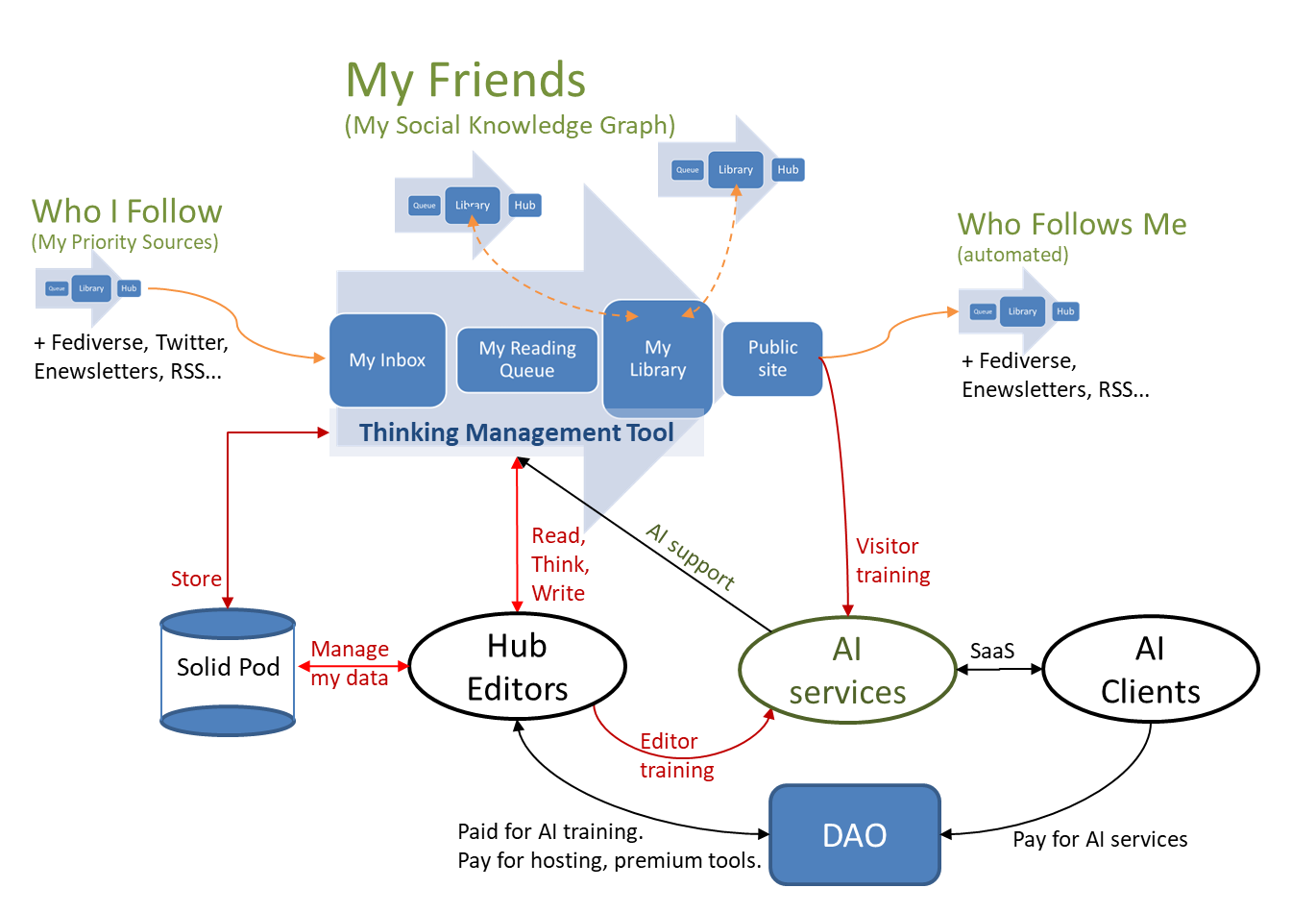A Minimum Viable Ecosystem for collective intelligence
What are the key elements required for decentralised collective intelligence, and how do we finance their development?
 Integrating thinking tools, publishing, decentralised social networks, AI and cooperative revenue models
Integrating thinking tools, publishing, decentralised social networks, AI and cooperative revenue models
This post summarises and introduces several others. Together they provide a snapshot of my current thinking into how a decentralised collective intelligence ecosystem could be bootstrapped into existence.
From reimagining MyHub.ai …
My starting point was to explore how MyHub.ai, a publishing platform I alpha-launched to explore these issues, could evolve. Briefly:
- MyHub.ai is currently a centralised platform where Hub Editors build their Hub — a personal website combining blogging (what I Think), personal porfolios (what I Do) and social bookmarking (what I Like)
- All content is tagged, and the natural language interface makes it easy to create Collections such as “Everything I Like, Think and Do tagged #creativity and #productivity”, each with its own RSS feed.
… to exploring collective intelligence
As I explored collective intelligence, however, I realised that my focus should be less on Hubs as a product, and more on the decentralised, open-source and self-sustaining ecosystem for collective intelligence within Hubs and many other products could thrive and evolve together.
This ecosystem will be built using open source tools and integrated with a library of AI services. The AI algorithms driving those services are trained as they are used, and are monetised via a SaaS. The resulting revenue then develops the ecosystem further, guided by a data union of users.
Many individual ecosystem components already exist
Many of the individual ecosystem components already exist: readers familiar with Tools4Thought, for example, will recognise the one I describe below as easily creatable by customising existing software, while the social technologies described below are already used by millions of Fediverse users and IndieWeb publishers.
So while my posts are partly about MyHub.ai’s evolution, that’s only because it remains my best entry point. I want MyHub.ai to evolve into an open-source “MyHub toolkit”, allowing anyone to self-host a Hub and plug it into the wider ecosystem, alongside digital gardens, substack-style newsletters, blogs and many other sorts of sites and apps.
Breaking down the above image
The figure, above, includes several key elements. Each is explored in more detail in dedicated posts (embedded below), but here’s a brief overview:
Super-Simple Tool4Thought for individual writers…
The Content Management Systems at the heart of each Hub is actually a Tool4Thought (centre of the image, blue). This could be hosted on MyHub.ai, self-hosted using the open-source MyHub toolkit, or built using any other Tools4Thought integrated with the ecosystem.
However, the ecosystem’s success relies on mass adoption (see revenue model, below), and so needs a Tool4Thought which is incredibly easy for mainstream users to adopt — the opposite of most Tools4Thought today. Moreover, while most Tools4Thought help people notes, we need one specifically designed to help writers transform their “atomic notes” into publishable content on the Tool4Thought’s public-facing edge (the Editor’s Hub, blog, newsletter, etc).
More on this Tool4Thought in Thinking and writing in a decentralised collective intelligence ecosystem
… networked into Social Knowledge Graphs...
Tools4Thought generally focus on helping individuals become more productive and creative. In this ecosystem, however, both the public sites and user-selected content in private Libraries are networked together socially using ActivityPub and other Fediverse technologies.
This creates collective intelligence: a personalised, decentralised Social Knowledge Graph for each user, expanding the knowledge available and creating collaborative possibilities (upper third of image, green).
More: Social knowledge graphs for collective intelligence
... with AI-powered cooperative revenue financing the ecosystem
Open-source tools built by volunteers and supported by well-wishers find it hard to compete with closed gardens’ advertising-powered critical mass. A new revenue source is required which remains under the control of the community using it (red, bottom).
It is based around AI services, provided free of charge to Editors via the Tool4Thought and trained by the Editors as they use them, and (in some cases) by visitors to the Editors’ public sites. These are monetised via SaaS, with the revenue reinvested in the ecosystem under the direction of a cooperative data union of Editors, as explored in How Artificial Intelligence will finance Collective Intelligence.
Dig deeper
You’ve just finished the “executive summary” of the following posts:
- Thinking and writing in a decentralised collective intelligence ecosystem
- Social knowledge graphs for collective intelligence
- How Artificial Intelligence will finance Collective Intelligence.
The site you're reading this on, finally, is the focus of our first pilot project: see About this project or the announcement post on Medium.
Comments welcome on all of them (How to comment), along with any contributions to the map (How to contribute).
Revision Notes
- Version 1 finalised on 1/1/2023 and reposted to Medium as a permanent version (see Wiki practice meets blogging).